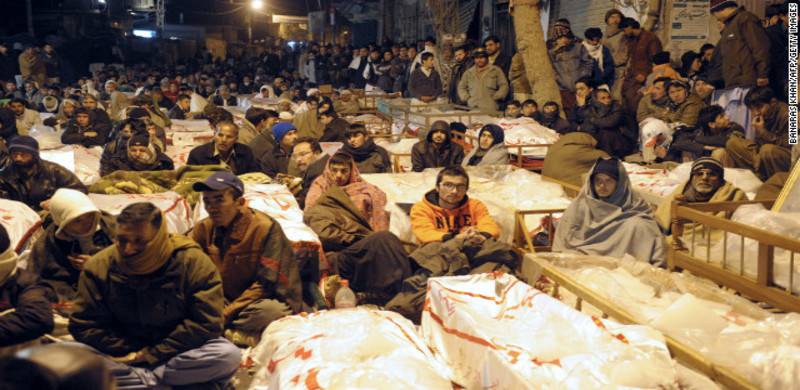
Today marks the seventh anniversary of the deadly Quetta bombings that killed close to 150 people, most of them from the minority Shia sect.
On 10th January 2013, three bombings were witnessed in Balochistan’s capital of Quetta, with residents describing the scenes of the bombings as ‘hell on earth’. All three attacks took place in the city’s area that is dominated by the Shia Hazara community. The Hazara community has frequently been at the receiving end of violence not only from Sunni sectarian groups, but also from Islamist terror groups like the Tehreek-e-Taliban Pakistan.
On that day, all three bombings targeted areas in Quetta dominated by Hazaras. The first attack took place in the morning near a public plaza, killing 12 people. The attack, according to BBC, was claimed by a Baloch separatist group, the United Baloch Army, and was reportedly targeted at Frontier Corps personnel.
The deadliest attack of the day was on Alamdar Road in the evening, when two bombs went of in close succession. A suicide bomber blew himself up inside a snooker hall, which was followed ten minutes later by a car bombing outside the building. Around 130 people were killed in the bombings, which were later claimed by Lashkar-e-Jhangvi.
The bombings triggered strong protests by the Hazara community, who refused to bury their dead until ample security was provided to their community, operations against Sunni militant groups were carried out, and the provincial government was dismissed.
Three days later, the then prime minister Raja Pervez Ashraf met with the protesters and agreed to implement one of their demands, that of dismissal of the government. He also agreed to put a governor in charge of the province. A day later, Balochistan chief minister Aslam Raisani and his cabinet were removed from their posts, and control of the province was handed over to governor Zulfiqar Ali Magsi.
The Shia community ended their three-day long, which had been held under freezing temperatures. The government was changed, but to this day, no one has received punishment for the heinous attacks on the Hazara community.
On 10th January 2013, three bombings were witnessed in Balochistan’s capital of Quetta, with residents describing the scenes of the bombings as ‘hell on earth’. All three attacks took place in the city’s area that is dominated by the Shia Hazara community. The Hazara community has frequently been at the receiving end of violence not only from Sunni sectarian groups, but also from Islamist terror groups like the Tehreek-e-Taliban Pakistan.
On that day, all three bombings targeted areas in Quetta dominated by Hazaras. The first attack took place in the morning near a public plaza, killing 12 people. The attack, according to BBC, was claimed by a Baloch separatist group, the United Baloch Army, and was reportedly targeted at Frontier Corps personnel.
The deadliest attack of the day was on Alamdar Road in the evening, when two bombs went of in close succession. A suicide bomber blew himself up inside a snooker hall, which was followed ten minutes later by a car bombing outside the building. Around 130 people were killed in the bombings, which were later claimed by Lashkar-e-Jhangvi.
The bombings triggered strong protests by the Hazara community, who refused to bury their dead until ample security was provided to their community, operations against Sunni militant groups were carried out, and the provincial government was dismissed.
Three days later, the then prime minister Raja Pervez Ashraf met with the protesters and agreed to implement one of their demands, that of dismissal of the government. He also agreed to put a governor in charge of the province. A day later, Balochistan chief minister Aslam Raisani and his cabinet were removed from their posts, and control of the province was handed over to governor Zulfiqar Ali Magsi.
The Shia community ended their three-day long, which had been held under freezing temperatures. The government was changed, but to this day, no one has received punishment for the heinous attacks on the Hazara community.
